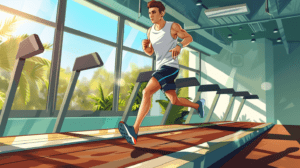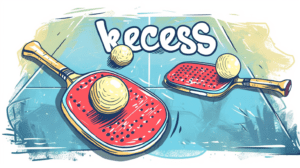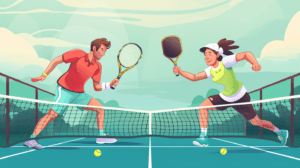Is Pickleball Bad For Your Back?
Last updated

Pickleball, a sport that’s sweeping the nation, is as addictive as it is fun. But if you’re nursing a sore back after a game, you’re not alone. I’ve been there, too, wincing with every move post-match.
In this article, we’ll explore the intricate dance of pickleball and its relationship with back health, offering insights and strategies to keep you swinging your paddle without the twinge of back pain.
Does Pickleball Cause Back Problems?
As a pickleball player, proper technique and conditioning are essential to reduce these risks.
Engaging your core muscles, maintaining a neutral spine, and adopting a balanced stance are crucial for protecting your back while enjoying the sport.
For a deeper understanding of this topic, read our detailed guide on what muscles pickleball works.
Is It Normal to Have Back Pain from Pickleball?
Experiencing back pain after a pickleball game is pretty standard, especially among players who dive into the sport without proper conditioning or adequate joint care for pickleball players.
The lower back, or the lumbar region, often bears the brunt of the impact due to the sport’s dynamic nature.
This discomfort can stem from muscle strains or ligament sprains caused by sudden, sharp movements or prolonged play.
Engaging in warm-up exercises and adopting correct postures can mitigate these pains greatly.
What Are The Common Back Issues in Pickleball
Upper Back Muscle Stiffness
The upper back, involving the thoracic spine and shoulder blades, can become stiff due to the repetitive swinging motions in pickleball. This stiffness is often a result of muscle overuse or tension.
Players might feel a tight sensation across their shoulders and upper back, sometimes extending to the neck. Regular stretching and strengthening exercises targeting these areas can alleviate the stiffness.
Spinal Stenosis
Spinal stenosis, characterized by the narrowing of spaces within the spine, can be exacerbated by the forward-leaning posture adopted in pickleball. This narrowing puts pressure on the nerves travelling through the spine, causing pain or cramping in the back and legs. Players with a history of spinal issues should take extra precautions and consult a healthcare professional for tailored advice.
Sciatica
Sciatica, a condition where the sciatic nerve gets irritated or compressed, can flare up in pickleball players. The sport’s sudden twists and turns can aggravate this condition, leading to sharp pain shooting down from the lower back to the legs.
Proper form, combined with exercises to strengthen the core and back muscles, can reduce the risk of sciatica.
Herniated Discs
Pickleball players might face the risk of herniated discs, especially when making powerful shots or abrupt movements. A herniated disc occurs when the nucleus of a spinal disc pushes out through a tear in the annulus, causing nerve irritation.
This can lead to pain, numbness, or weakness in the back and legs. Players should maintain a strong core to support their spine during play.
Remedies for Sore Lower Back After Pickleball
Specific stretching exercises can be highly effective for immediate relief from lower back soreness after pickleball. For instance, the ‘cat-cow’ stretch is excellent for loosening the lower back muscles.
Begin on all fours, arch your back towards the ceiling (like a cat), and then dip it towards the floor, lifting your head up. This movement increases flexibility and eases tension.
Using a tennis or lacrosse ball for self-myofascial release is another effective technique. Place the ball under the sore areas of your lower back while lying on the ground, gently rolling over it to massage and release muscle knots.
How to Prevent Back Pain in Pickleball
Incorporating methodologies from “Becoming a Supple Leopard” by Dr. Kelly Starrett can significantly aid in preventing back pain in pickleball. This approach emphasizes proper body mechanics and functional movement, which are key in reducing the risk of back injuries.
Maintaining a strong, flexible core, practising good posture, and using efficient movement patterns during gameplay can help safeguard against back-related issues.
Regularly engaging in exercises that enhance mobility and stability, especially in the lumbar and thoracic regions, is beneficial.
Pay attention to your body’s signals and rest when needed; don’t push through pain barriers which could exacerbate underlying issues.
Is Pickleball Bad For Your Back Conclusion
While pickleball is a fun and exciting sport that can provide hours of enjoyment, it’s essential to be aware of its potential risks to your back health.
Back pain, stiffness, and even more severe conditions like spinal stenosis or herniated discs can result from the game’s dynamic nature. However, with the right approach, including proper warm-up, technique, and conditioning, you can significantly reduce the chances of experiencing back problems.
Incorporating exercises to strengthen your core and practising good posture are crucial steps towards a healthier and pain-free pickleball experience.







